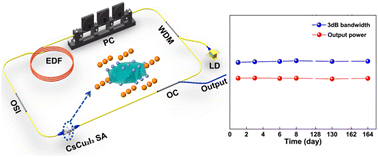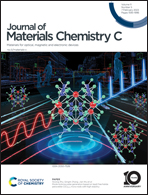Mode-locking pulse generation based on lead-free halide perovskite CsCu2I3 micro-rods with high stability†
Abstract
The industrialization and commercialization of optoelectronic devices require the exploration of novel materials with high stability, nontoxicity, and large-scale manufacturing. The all-inorganic lead-free halide perovskite nanomaterial CsCu2I3 has been widely reported in applications in light-emitting diodes (LEDs), photodetectors (PDs), photovoltaics, and so on, due to its good environmental stability and unique optoelectronic properties. However, research on ultrafast photonics has rarely been carried out so far. Here, high quality CsCu2I3 micro-rods were fabricated via a solvent evaporation crystallization method. The high thermodynamic stability and the broadband response of CsCu2I3-based optoelectronic devices have been predicted by density functional theory (DFT), revealing their feasibility for exploitation in fiber laser systems. The nonlinear characteristic of CsCu2I3 micro-rods was measured using a balanced twin-detector system, with a modulation depth of 12.04%. Utilizing its remarkable nonlinear optical response and intrinsic stability, a passively mode-locked erbium-doped fiber laser based on a CsCu2I3 saturable absorber was achieved. Significantly, the fiber laser could operate stably for at least five months. These experimental results demonstrate that CsCu2I3 micro-rods are ultra-stable, and can serve as a promising optical modulation material to produce an ultrafast and long-stability pulse in fiber laser applications.

- This article is part of the themed collections: 2024 Journal of Materials Chemistry C Lunar New Year collection, Stability of Optoelectronic Materials and Devices and 2023 Journal of Materials Chemistry C Most Popular Articles


 Please wait while we load your content...
Please wait while we load your content...